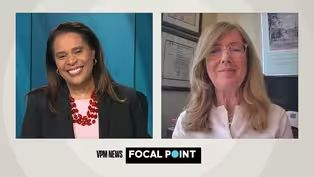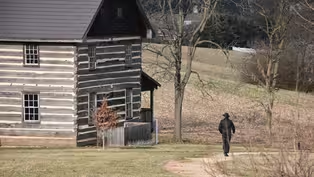VPM News Focal Point
International school addresses learning loss
Clip: Season 3 Episode 10 | 4m 13sVideo has Closed Captions
Unique school within a school says their methods are effective against learning loss.
Within Alexandria's Hammond Middle School, the International Academy is at work, serving students from dozens of different countries and from all types of educational backgrounds. School leaders say the kind of learning loss experienced by most public school students during the pandemic is mitigated by the very methods the International Academy employs every school day of the year.
Problems playing video? | Closed Captioning Feedback
Problems playing video? | Closed Captioning Feedback
VPM News Focal Point is a local public television program presented by VPM
The Estate of Mrs. Ann Lee Saunders Brown
VPM News Focal Point
International school addresses learning loss
Clip: Season 3 Episode 10 | 4m 13sVideo has Closed Captions
Within Alexandria's Hammond Middle School, the International Academy is at work, serving students from dozens of different countries and from all types of educational backgrounds. School leaders say the kind of learning loss experienced by most public school students during the pandemic is mitigated by the very methods the International Academy employs every school day of the year.
Problems playing video? | Closed Captioning Feedback
How to Watch VPM News Focal Point
VPM News Focal Point is available to stream on pbs.org and the free PBS App, available on iPhone, Apple TV, Android TV, Android smartphones, Amazon Fire TV, Amazon Fire Tablet, Roku, Samsung Smart TV, and Vizio.
Providing Support for PBS.org
Learn Moreabout PBS online sponsorship(birds singing) TIM BRANNON: The International Academy operates kind of like a school within a school.
We have anywhere between 150 to 250 students depending on the time of the school year.
Usually at the beginning of the year, we have fewer students, and as students arrive, a lot of the new students are offered services in the International Academy because a lot of our new students are immigrants when they arrive at our school.
We have about 55% of our students are from Afghanistan.
That's a newer trend in the last two or three years where they're our largest population of students.
Those students primarily speak Dari or Pashto as their first language.
About 40% of our students are Spanish-speaking students, primarily from Central America.
However, we do have a handful of students that are from South America as well.
The remainder of our students are made up of a variety of different countries around the world, Ethiopia, Ukraine, Saudi Arabia, Philippines.
(students speaking in foreign language) JESSIE PARE': As a team, we do collect a lot of data on our students, and we drive our education based on that data.
I have lots of literacy data on my students that I keep track of.
I give them small-group interventions, one-on-one interventions as well in monitoring their progress throughout the year, but also outside of just a data point, we talk about our students' social and emotional needs as well, so if we see there are things that they need support in that area, we address that very deeply, because we believe that as long as they feel safe in our school, that's when the learning's going to start.
If they don't feel safe or they don't know how to express themselves in a healthy way, learning can't happen.
STUDENT: Oh wait, I have to count the period?
TIM BRANNON: During COVID, when we were virtually learning, we provided kids with a lot of things to try to make it as positive an experience as it was given the circumstances.
They had laptops, we provided families with Wi-Fi devices they could have in their homes.
However, virtual learning is not the best practice for most anybody, but specifically for English language learners who are trying to learn a new language, it's really difficult for them to collaborate with their peers, it's difficult for them to engage in all of the language domains.
For some of the families that are living in shared homes or shared apartments, having multiple children attempting to access Zoom classes at the same time is very challenging.
So it does create learning loss in that area.
On the flip side, our program is designed to deal with that.
JESSIE PARE': We've been established since 2015, I've been here for seven years, and that has been our goal the entire time, is to see what possible gaps our students have and to be able to close those gaps as closely as possible.
TIM BRANNON: Our students come to us all the time with diverse educational experiences.
Some of our students come to us from a country where they went to school seven hours a day, five days a week, just like we do here.
However, we have other students who might've gone to school two or three days a week, two or three hours a day, for a few months a year rather than for eight months during the year.
We have some students who haven't gone to school for multiple years for a variety of different reasons.
All of those students have experienced learning loss and interruptions to their education, something that now all of us experienced during the pandemic.
JESSIE PARE': Do you know how to write the draft?
STUDENTS: Yes.
JESSIE PARE': Do you know how to put it together?
STUDENTS: Yes.
JESSIE PARE': Right, so are you ready to write a paragraph?
STUDENTS: Yes.
JESSIE PARE': Yes, you are.
I think one of the biggest things for English language learners is that when they are learning things for the very first time, I think some people assume that they don't know certain things just because of their own educational history.
However, our students are coming in with a plethora of knowledge that many of us don't have.
For example, if they're in science class, they can have firsthand accounts of how farm life is working, or what city life is like, or when we're talking about even heavier topics, they have firsthand accounts of what's going on with that, and being able to have those deeper conversations.
So for our students, they just need a way in the door, and then they can do anything they absolutely want.
Dr. Lauranett Lee on the Great Migration
Video has Closed Captions
Clip: S3 Ep10 | 12m 49s | Historian talks about the reasons and the consequences of Black people leaving the South (12m 49s)
Video has Closed Captions
Clip: S3 Ep10 | 2m 57s | Its location has led the Richmond metro to be among the fastest growing areas in the state. (2m 57s)
How Latinos are contributing to life on the Eastern Shore
Video has Closed Captions
Clip: S3 Ep10 | 7m 52s | Having once arrived with dreams of opportunity, Latinos now call the Eastern Shore home. (7m 52s)
Mass migration: Why are people moving south?
Video has Closed Captions
Clip: S3 Ep10 | 7m 9s | People are moving to the South en masse. Only some Virginia areas are benefiting. (7m 9s)
Modern diversity dates back to early immigrants
Video has Closed Captions
Clip: S3 Ep10 | 6m 38s | Descendants of early Mennonite immigrants speak about the impact on the Shenandoah Valley (6m 38s)
Running a Latin American restaurant on Southside
Video has Closed Captions
Clip: S3 Ep10 | 3m 54s | A Salvadoran migrant to Southside Richmond is chasing the American dream. (3m 54s)
Providing Support for PBS.org
Learn Moreabout PBS online sponsorship
- News and Public Affairs

Top journalists deliver compelling original analysis of the hour's headlines.

- News and Public Affairs

FRONTLINE is investigative journalism that questions, explains and changes our world.












Support for PBS provided by:
VPM News Focal Point is a local public television program presented by VPM
The Estate of Mrs. Ann Lee Saunders Brown





